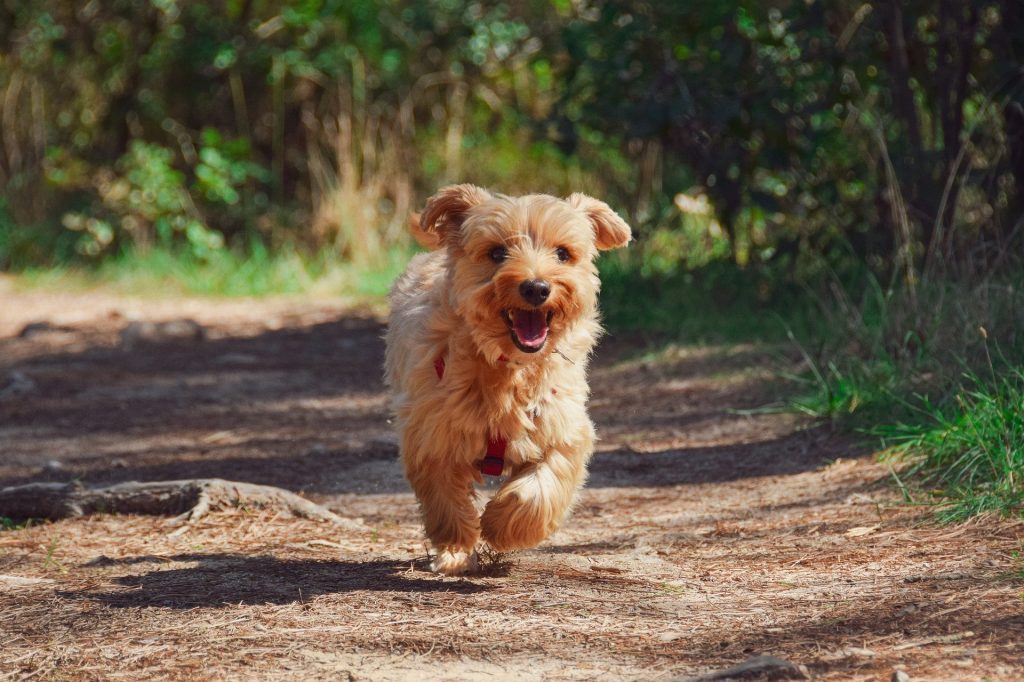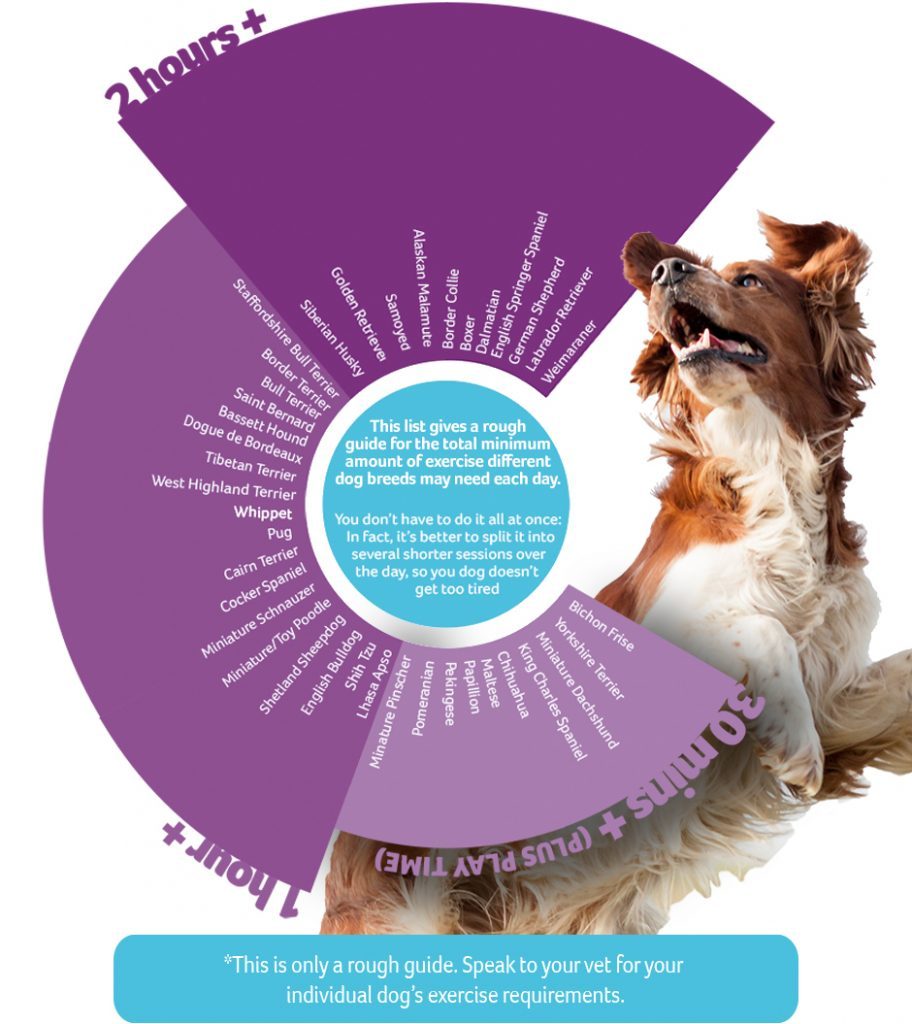Just like humans, exercise is essential for dogs. Not only does it keep their body fit and healthy, but it keeps their minds fit and healthy too. In 2019, research from the PDSA Animal Wellbeing (PAW) report showed that thousands of dogs in the UK are never walked…at all.
Having regular exercise and exploring new places helps keep your dog’s brains active and is a great stress reliever for them; you may think that dogs have nothing to be stressed about, but actually little things such as a change in routine, a new carpet freshener can cause a dog stress. Read more about that, here. What’s more, is that the sniffing and exploring that s dog does is all helping them learn. So make sure your dog has plenty of opportunities to just, well, be a dog!
Not getting enough exercise can also cause obvious health issues such as obesity, but also less well-known mental issues such as behavioural problems. Bored dogs are unhappy dogs and they show their frustrations by chewing things they shouldn’t do, barking a lot, having “accidents” in the house and over-grooming (licking too much).
More exercise can help alleviate these problems, but it’s important to talk to your vet if you’re worried about their behaviour.
How much exercise is the right amount of exercise for your dog?
Well, that all depends on their weight, breed, age, health and personality.
The PDSA has created a great diagram that gives a rough guide on how much exercise each breed of dog needs. But every dog is individual and may be different to other dogs that are the same breed that they are, for example, Pawfit Pals Coby and Reggie are both Cocker Poo’s, but Reggie loved to run around and have lots of playtimes, whereas Coby enjoys long walks. For advice on how much exercise your dog needs, it’s always best to speak to your vet.
The Pawfit device allows you to input data on such as breed, weight, age and gives you the opportunity to set goals for how many steps they should do based on those dimensions.
Exercising your dogs at different ages
As we just mentioned, there are lots of factors that contribute to how much exercise your dog needs, and this includes age too. Your puppy, for example, would not and should not be expected to do a two-hour walk, and that’s the same for older dogs too. They might not be able to keep up with you like they used too.
Check out our article on how much exercise your puppy should be getting, here.
Exercising your dog if they are poorly
If your dog is poorly or suffering from a long-term health condition, it may not be possible for them to have lots of exercise.
Your vet will be able to give you advice on how much exercise your dog will need depending on their health condition or illness, so you’re doing the best for them.
Different types of doggy exercise
It’s good to mix up your dog’s routine a lot so they don’t get bored. Obviously, you need to make sure they’re getting at least one walk daily, but on top of that, they should be doing other types of exercise, too.
Ideally, you should mix plenty of playtime and training into your dog’s daily exercise routine. This will help the two of you bond and keep their brain active along with their body. They should also be able to spend time off-lead in a secure area to have a run and sniff. If this is your garden, make sure it’s a good size for your breed (e.g. bigger dogs need bigger gardens), is secure and dog friendly.
If your dog doesn’t have a good recall you could always consider researching local secure dog play areas to make sure they get a chance to run free and have lots of fun.
Remember, walking needs to be a daily routine, not just something you do at weekends. This is especially important for overweight dogs, but also important for older dogs who may be a bit stiffer but will enjoy time outdoors to have a good sniff around. If you can’t walk them yourself, ask a friend, or a professional dog-walker so your dog doesn’t miss out.
Always check with your vet that the exercise programme you’ve planned is suitable for your dog.
My dog doesn’t like walks
Just like people, not all dogs particularly enjoy exercise and all dogs have very different exercise needs. You can often find dogs of the same breed will be completely different with one being high energy and one much more laid-back.
Sadly, in some cases, some dogs can be afraid of the great outdoors. It’s really important to speak to your vet or an accredited behaviourist if your dog seems worried. Don’t force your dog out as this will be very unpleasant for both of you and could lead to your dog developing phobias.
Obviously, it’s important that your dog still has at least one walk a day, but if they’re not particularly keen on walking (and with advice from an accredited behaviourist) you can make up their exercise needs in another way, for example, through playtime, running around the garden a lot and having lots of fun interactive games.
Sometimes, our dogs don’t seem to enjoy walks if we rush them. Make sure your dog gets at least one walk a day where they’re allowed to stop and have a good sniff around. If they feel rushed they’re less likely to enjoy the walk and may be reluctant to take particular routes if they don’t think are fun.
If you’re thinking of getting a dog and love to go on long walks, make sure you do your research on different breeds first to help choose one that matches your lifestyle. There’s no guarantee that every dog of a certain breed will like walking, but by looking for breeds that enjoy a lot of exercises you’re more likely to end up with a canine pal that does.
Walking your dog: top tips
- Always allow your dog to have a good sniff around – this is important for their mental health.
- Don’t throw sticks for your dog to chase – they can splinter and injure your dog’s mouth and throat.
- Throwing balls – if you throw a ball, make sure it’s not small enough for your dog to swallow.
- Walks and games are a much better treat than food!
- ‘Varied walking’ can be good for you and your dog – this is where you speed-walk for about 30 seconds, walk at a normal pace for about a minute, then speed up again and so on. It’s a really good exercise for both of you and something you can do randomly throughout your walk.
- Exercise as much as necessary – if your dog isn’t getting tired, or is still full of energy when you get home, they may need more exercise. If your dog is struggling or refuses to go at all, you may need to cut back!
- Try to vary your route – to keep your walks interesting and exciting.
- Keep dogs on a lead in built-up areas – only let them off when you are absolutely sure it is safe. This ensures your dog isn’t a nuisance to others and protects it from traffic, litter and other hazards. It is also important to keep your dog on a lead around sheep and other livestock.
- Identification – always make sure your dog is wearing a collar and tag and has their microchip details up to date with the database. Your Pawfit device has a GPS tracker within it as well as an audio ID tag, in case your pet goes missing.
- Seasonal walks – during the winter months you should also consider using high visibility jackets, hi-vis or LED collars and leads to be seen and keep safe. During the hot summer months, you may need to walk your dog during the cooler hours.
- Poo bags – always carry plenty of poo bags and dispose of them inappropriate bins.
Fun ways to exercise your dog

- Make them work for their food. Using a feeding toy instead of a food bowl is a fun way to feed your dog at the same time as getting them to burn extra calories.
- Sniff it out. Dogs have an excellent sense of smell and this can form a fun game. Use one of their favourite toys or part of their food allowance to create a scent trail by rubbing it on the floor at regular intervals. Hide the toy or food at the end of the trail as a great reward.
- Jump to it. For more mobile dogs you can use a plastic hula hoop held upright, just off the ground and get your dog to walk through it. Give them lots of praise once they jump through and gradually increase the height off the floor to get them jumping higher and burning those calories.
- Get them to ‘step-up’ to the challenge. You can use a flight of stairs for any dog who is mobile. Leave your dog at the bottom of the stairs and walk to the top yourself. Call your dog to you, at the top of the stairs and reward them with some fuss or a game with their favourite toy. You can repeat this a few times but stop if they seem tired or out of breath.




